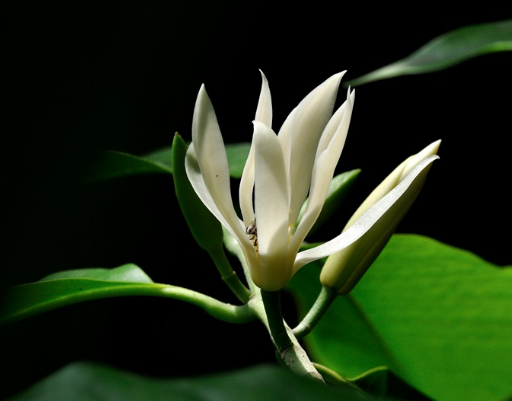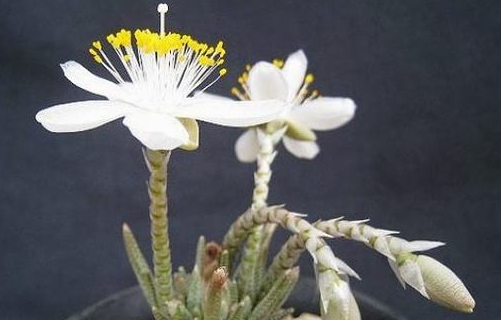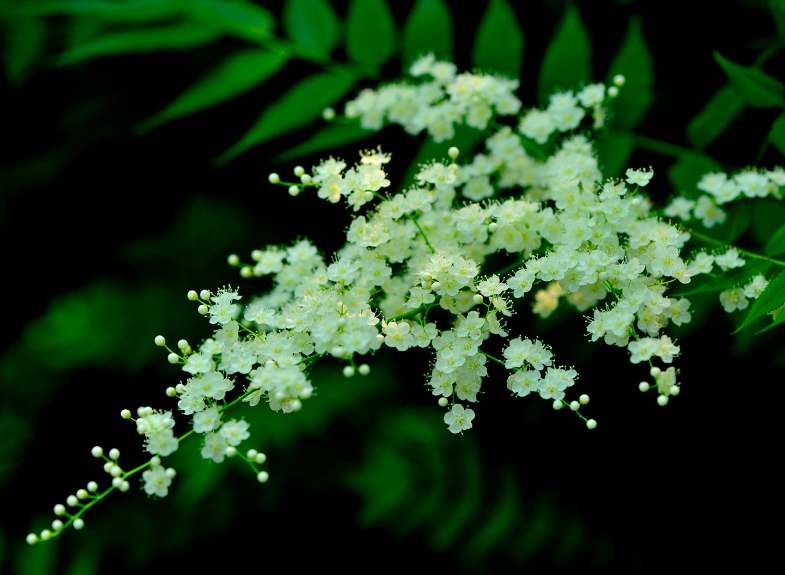Culture method of white orchid
Basin soil selection
The soil of white orchid should be loose and fertile, drained and breathable and rich in humus. The granular soils with different shapes have better permeability and drainage.
The selection of flowerpots is also marked with good air permeability, such as mud pots, purple sand pots and plastic pots with many bottom holes, and the size of flowerpots should be selected according to the size of the crown and the growth years of the plant.

Change the basin
The white orchid grows rapidly, so it is necessary to change the basin timely, stop watering when the basin is dry, tilt the basin slightly or upside down, hold the basin and hold the plant with your hand, and pour it out. Clean up the soil on the roots, cut off the rotten and aging roots, put them in a new basin, properly apply base fertilizer, and pour enough water on it.
Planting position
White orchid potted plants are moved outdoors from March to April each year and can be placed in a place with plenty of light. When it is hot in summer, sunshade net or simple shade shed should be used for cooling maintenance, so that the white orchid can receive sufficient light, at the same time, excessive direct light can be avoided and the branches and leaves of the white orchid can be prevented from being burned by exposure.
Pruning
Attention should be paid to the selection of height when pruning terminal buds and shortening some lateral branches, and the appropriate pruning position will promote lateral branches, buds and flowering. Before the white orchid is placed indoors, the dry, overgrown, infected and overdense branches should be cut off to minimize the consumption of nutrients; when placed outdoors, the old leaves at the bottom of the branches can be removed as appropriate, which is beneficial to the growth of new branches.
Fertilizer application
White orchid compare Xi fertilizer, in the growing period every semimonthly to fertilize once, can choose compound fertilizer, each time 2-6 grams, pay attention to fertilization do not put fertilizer directly in contact with the root, avoid "burning root". Stop fertilizing in winter, fertilize and water once every 3-4 days in the growing period, and once every 5-6 days in the flowering period. Of course, the frequent application of thin fertilizer can change the number of fertilizers according to the situation.
Watering
White orchid watering must not be excessive, excessive watering will lead to stagnant water rotten roots, watering to "do not dry do not water" as the principle, summer high temperature or air dry can be around the plant appropriate amount of water, rainy season should be timely pour out the stagnant water in the basin.
Temperature
White orchids are vulnerable to cold damage, so temperature is the key to whether they can safely survive the winter. Outside South China, they should be kept indoors in winter, and the lowest room temperature should be kept above 5 ℃ until Qingming Festival and Grain Rain can be placed outdoors again. In the high temperature weather in summer, effective measures should be taken to cool down the white orchid.
Light
White orchids like the environment with sufficient light, but if the summer light is too strong, we should also take certain shading measures to avoid direct light, and generally pay attention to the light at noon. Indoor farming should be placed in a position with plenty of light.
Pest control
Common diseases of white orchid include yellowing, root rot and anthrax. Before the occurrence of the disease, the resistance of the plant should be enhanced by ventilation, loosening the soil and controlling watering; after the disease occurs, scientific liquid spraying should be carried out immediately.
Common pests are red spiders, shell insects, aphids and other insects. Before the occurrence of insect pests, it is necessary to spray water frequently to increase the humidity to prevent them; after the occurrence of insect pests, clean water can be used to wash the leaves, and insecticides should be sprayed in serious cases.
Reproduction
White orchids can be propagated by grafting, cutting, striping and sowing, but grafting and striping are usually used.
Striping should be carried out from June to July, using high-altitude striping method and keeping the plant moist, it will take root in about 2 months.
The biennial branches should be selected for the grafted rootstocks, and the branches of the same thickness as the rootstocks should be used in the Meiyu season. After the grafting is completed, they can heal in about 60-70 days, and then cut off from the mother plant.
How to raise white orchids? Guide to culture methods and maintenance of white orchids
White orchid, white and elegant, but has a unique smell, loved by flower friends, but now the number of Magnolia is relatively small, the number of farmers is not very large. I don't know if the majority of flower friends have ever raised this kind of flower. In the blooming season of Prynne, there are old people who come out to sell flowers. They use wire to string the flowers together, and they can also hang them on their bodies to look very good. As the white orchid can not be cut, we usually choose grafting or striping method to propagate, although this operation is complicated, but conditional flower friends can give it a try.
The method of grafting is to drill wood, usually with 2-3-year-old Yumu Michelia, magnolia tree, in May and June, we can put the branches of Magnolia grafted on the drill wood, wrapped in plastic film for normal maintenance, the pressing method is best to use more than three years of Magnolia, choose the top 1-2-year-old stout branches, branches to be longer than 15 cm, adjust the last 5 cm, cut off, 3prime 4 skin After sowing, spray carbendazim solution to disinfect, then wrap it with slightly wet soil, fix it in the peeling position, spray water to keep the soil moist, and cut the branches below about ten days later.
After carving a little bit every week and lasting for two months, after cutting off the branches, you can basically take root at this time, you can plant them directly, and then you can buy the seedlings of white orchids directly if it is too troublesome. Now the seedlings of white orchids are not too expensive, but they must distinguish between true and false. White orchids grow slowly, and some flower friends will buy seedlings grown for more than a year to raise them. Everyone says that white orchids are delicate, but they can be cultivated for decades after they have been cultivated regularly. What kind of soil do white orchids use? flowers like trees should be planted with sturdier original pictures or mixed with rotten leaf soil.
Flowerpots, pottery pots or porcelain powders, pots with good air permeability, brandy are more sensitive to water quality, we had better use clean tap water, precipitate and then water them, he prefers water to be afraid of waterlogging, and it is not suitable to water a lot of water each time. Spray watering is recommended, which can not only clean the leaves of Magnolia but also make the leaves and branches drink full of water. Can Magnolia be sunburned? Prynne likes the sun better, but when he climbs the mountain, he'd better put it in a place with better light at home, but he must pay attention to avoiding the shade in summer.
Light can be seen before 10:00 in the morning, and it must be moved to a shady place after time. Magnolia's yellow leaves and swapping are problems. The southern rubber soil that is usually chosen by the Magnolia in the flower market is very sticky. Flower friends usually put it indoors without ventilation when they buy it. In addition, the pot soil is impervious and waterlogged, so the flowers and leaves will rot, and the magnolia will not live long. Plant a white orchid at home. Simple and easy to raise, it can make the whole room fragrant.
But we usually buy clay magnolia, we must first wash the roots, but be careful not to hurt the roots, we dry and then re-plant in this breathable garden soil and mixed compound leaf soil, so that we can raise them at home. If we don't want to wash the roots and change the soil, we'd better put the newly bought magnolia in a ventilated yard or balcony.
White orchids bloom as long as in summer and autumn, winter is not cold-resistant to keep warm, if we raise well, we can also open grafted magnolia and have grown to about 50 cm before they can blossom, the striping will be a little earlier, the bud can be picked off, with thread, hanging at the head of the bed will have a calming effect.
White orchid pruning method, how to cultivate white orchid
White orchid pruning method:
In the summer when the white orchid is growing vigorously, the 3mur5cm area with new buds is selected for pruning. After pruning, the wound is sealed with a mass of mud mixed with fungicides and auxin, and the outside is tightly wrapped with small plastic film.
Conclusion: do you understand the above knowledge about how to raise white orchids? The fragrance of the white orchid is the most impressive, although the flower is petite, but it is fragrant to the nostrils, and the fragrance of the white orchid is different from that of other flowers, it is a kind of fragrance without pride and impatience, it is a kind of fragrance that people miss very much.
How to raise white orchids: watering: proper watering is the key to the maintenance of white orchids. White orchids like a humid environment and are not resistant to drought. But it is fleshy root, if the drainage in the basin is not good, stagnant water will inevitably cause root rot. Therefore, it should not be watered too frequently, too much, the principle of watering Magnolia should be less than more, each watering should be thoroughly watered.
Spring and autumn can be watered once a day, watering should be appropriate according to the size of the basin, watering to ensure that the root system can absorb water, but will not cause stagnant water.
In summer, once in the morning and evening, foliar water should be sprayed when it is too dry. Generally speaking, as long as you see the leaves drooping, it is time to water. If the soil temperature is high at noon and there are occasional showers, the water temperature in the basin will rise, which is extremely disadvantageous to the roots and should be watered immediately to cool down.
Winter potted flower room, to let the soil surface dry and then watered, watering thoroughly. If it is found that the branches are withered and yellow, it may be caused by excessive dampness in the roots, so the moisture should be controlled immediately and the soil should be loosened. If the leaves are found to wilt suddenly, it may be caused by the drying of the basin soil, so it should be watered in time and restored in a cool place.
On rainy days, it is necessary to prevent stagnant water in the basin and pour out the stagnant water in the basin at any time.
It is best to use Rain Water or river pond water. If tap water is used, it should be placed in the basin for about 2 hours before watering. Do not use stagnant water that has been stored for a long time, and do not use water that contains more impurities and is slightly alkaline.
The water temperature required to water flowers in summer is slightly lower than the soil temperature and higher in winter.
Fertilization: fertilization: White orchid has a longer flowering period, more flowering times and a large consumption of nutrients, so it is necessary to add topdressing frequently and apply frequently.
After leaving the room, you can apply 6-7 times light liquid fertilizer, once every other week.
During the peak growth period, that is, from May to June or from July to August, flower fertilizer can be applied every half a month, or a little nitrogen, phosphorus and potassium compound fertilizer can be applied every 20 days or so, about 2g to 6g each time. When fertilizing, do not spread the fertilizer directly to the root of the plant, it is easy to burn the root, you can draw a few ditches in the basin, then spread the fertilizer into the ditch, cover it with basin topsoil, pour some water, and let the fertilizer slowly seep through the root of the plant with the water.
Liquid fertilizer based on phosphorus and potassium should be applied every 3-4 days at full flowering stage. Fertilization should be carried out after the basin soil is dry in the evening on a sunny day, and permeable water should be irrigated the next day to facilitate root absorption and avoid root burning.
Sunshine: the white orchid is naturally very fond of the sun, so its growth environment is inseparable from the sun, but we must pay attention to prevent drought in summer. The sun terrace in summer is too strong. If there is no careful care, the white orchid is easy to dry and wither. "
- Prev

How to raise White Flower tenderness Brocade
1. Planting soil if we are cutting white flower brocade, we need to choose loose and fertile soil, and in order to prevent stagnant water and root respiration, our soil also needs to have good drainage and ventilation, so that the basin soil will not have stagnant water, and the roots can breathe normally.
- Next

Is pearl plum suitable for indoor farming?
Pearl plum can be cultured indoors, but because pearl plum is a shrub plant, it usually needs to change pots and trim roots after a few years of rapid growth, so it is usually used as a bonsai culture and ornamental. Daily maintenance requires frequent pruning in order to keep the plant shape beautiful and control the plant size so that it does not take up too much indoor space.
Related
- Fuxing push coffee new agricultural production and marketing class: lack of small-scale processing plants
- Jujube rice field leisure farm deep ploughing Yilan for five years to create a space for organic food and play
- Nongyu Farm-A trial of organic papaya for brave women with advanced technology
- Four points for attention in the prevention and control of diseases and insect pests of edible fungi
- How to add nutrient solution to Edible Fungi
- Is there any good way to control edible fungus mites?
- Open Inoculation Technology of Edible Fungi
- Is there any clever way to use fertilizer for edible fungus in winter?
- What agents are used to kill the pathogens of edible fungi in the mushroom shed?
- Rapid drying of Edible Fungi

